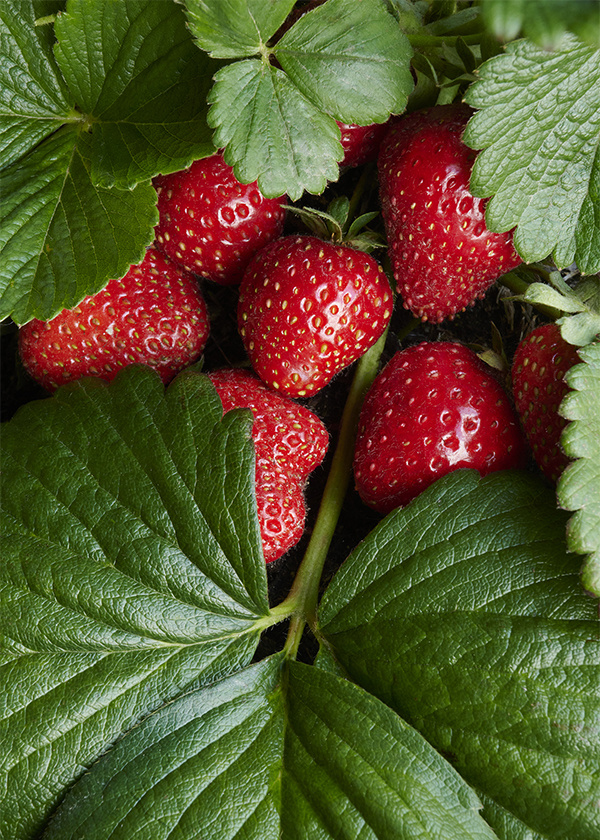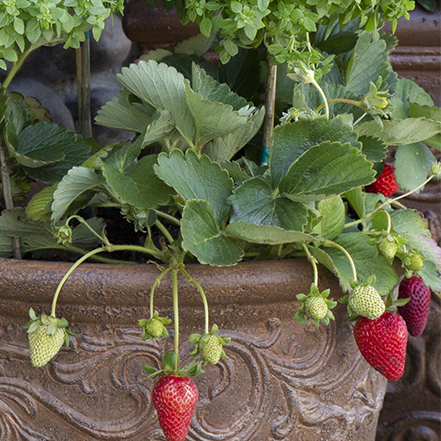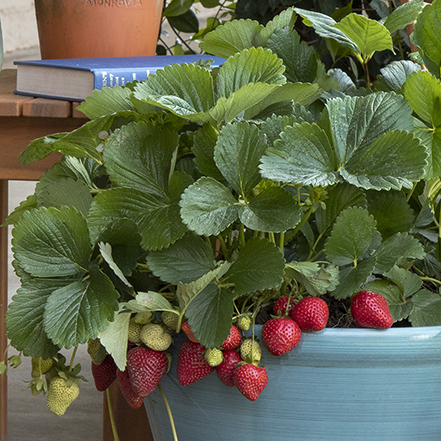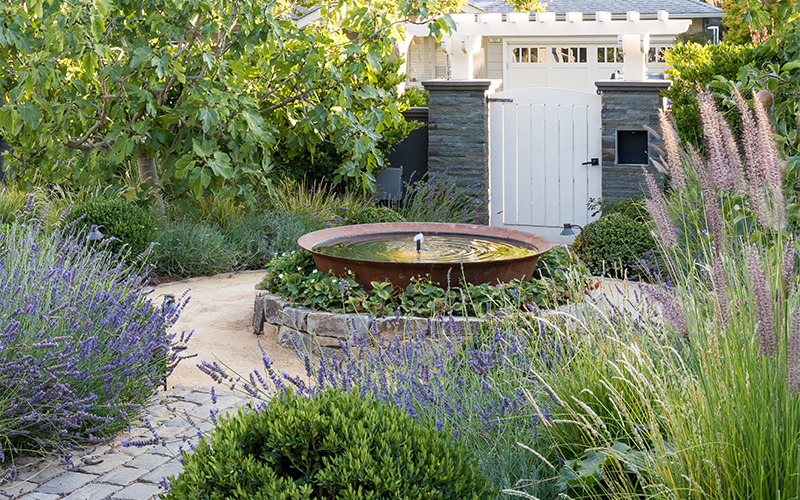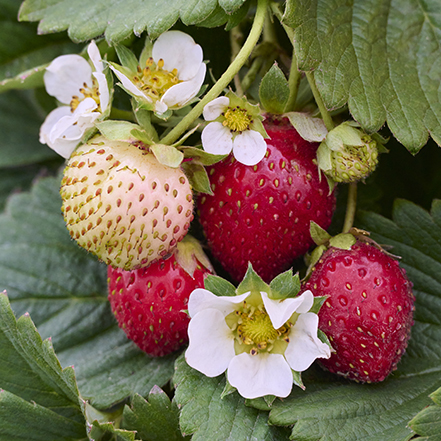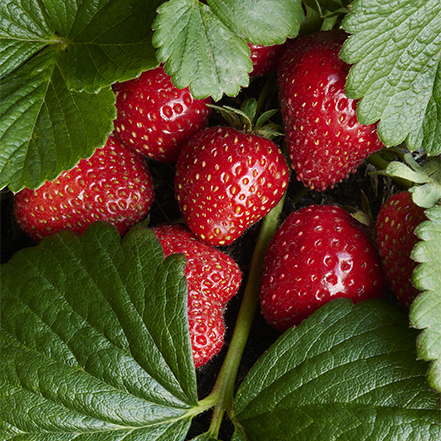Traditionally, strawberries have been grown primarily for their sweet, delicious, and nutritious berries. No surprise there. But given a number of converging gardening trends, there’s a new crop of gardeners who are adding strawberries to their home gardens to play double-duty as an edible, as well as a beautiful ground cover, border, or container plant. Strawberries are also easy to care for, making them a great option for both experienced and novice gardeners.
In this article, we'll go over all that you need to know to confidently grow strawberries in your own garden, including types of strawberries, how to plant them, using strawberries in garden design, and how to care for and harvest them.
And if that’s not enough, we’ve shared one of our favorite strawberry recipes— Strawberry and Angel Food Cake Trifle. What’s not to love about that?
Table of Contents
1. Common strawberry questions
2. Strawberry planting basics
3. Strawberry care basics
4. Strawberry harvest and storage
5. Using strawberries in garden design
6. Best strawberries for production and taste
7. Strawberry trifle recipe
If you have anything you’d like to share about growing strawberries that you feel others could benefit from, please tag us on social media @MonroviaPlants. And that includes sharing your favorite strawberry recipes that highlight their tasty goodness!
1. Common strawberry questions
Before we get too deep into the nitty gritty of growing strawberries, let’s answer two of the most common strawberry-related questions.
What are the different types of strawberries?
Many gardeners may not realize that not all strawberries are the same. In fact, there are three main types: June-bearing, everbearing, and day-neutral, with the primary difference being when and how often they fruit.
(Above) San Andreas Strawberry is a day-neutral variety that produces fruit continuously throughout the summer.
(Above) Seascape Strawberry is a highly productive ever-bearing variety that yields delicious berries twice throughout the summer.
June-bearing strawberries typically bear fruit in June, as their name suggests. They are known for their large, sweet berries that are perfect for eating fresh or making jams, jellies, and pies. However, the downside of June-bearing strawberries is that they only produce fruit once a year, so you'll need to wait until the next growing season to enjoy another tasty bite.
Everbearing strawberries, on the other hand, produce fruit twice a year, once in the spring and again in the fall. They are smaller than June-bearing strawberries but have a longer growing season. This makes them ideal for gardeners who want to have a steady supply of fresh strawberries throughout the year. However, their fruit is not as large or as sweet as June-bearing strawberries. Three varieties of everbearing strawberries to consider are Seascape Strawberry; Albion Strawberry; and Eversweet Strawberry.
Day-neutral strawberries produce fruit throughout the growing season, from spring until the first frost. This means that you can enjoy fresh strawberries all season long – also making them perfect for gardeners who want a continuous supply of berries. Day-neutral strawberries are also known for their sweetness and flavor, which is comparable to June-bearing strawberries. However, they tend to produce smaller fruit than June-bearing strawberries. The San Andreas Strawberry is a great day-neutral choice.
All three types of strawberries are great, but it’s important to know what type you’re planting to properly set your expectations. Otherwise, you may be wondering why your strawberries stopped producing when your neighbor’s are still busting out the berries!
Are strawberries perennials?
Yes, strawberries are considered perennials—which means they come back year after year. However, unlike many other perennials, they don’t live a very long time. Even under perfect conditions strawberries only live for about 5 or 6 years, with their fruit production starting to wane after the first year. For this reason, many gardeners treat them as annuals or biannuals and replant them every year or two.
This can be frustrating to some gardeners; but relatively speaking, for their size, strawberries are incredibly productive. All that hard work takes a lot out of them, so as they decline, they will succumb to typical environmental issues (e.g., fungi, pests, and leaf spots).
So, enjoy them while they last, as they give you their all!
2. Planting Strawberries: Where, When and How to Plant Strawberries
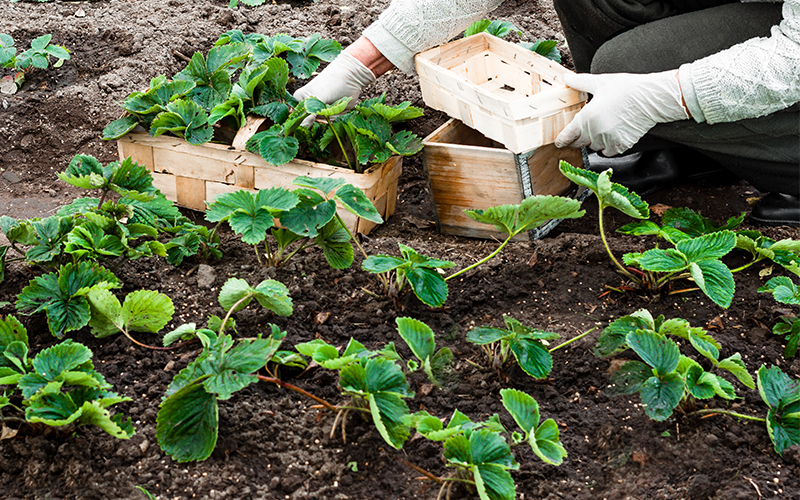
Where to Plant Strawberries
- Strawberries prefer well-draining soil and full sun (6-8 hours), although they can tolerate some shade.
- Make sure the soil is fertile and rich in organic matter, with a pH between 5.5 and 6.5.
- If your soil is heavy or has poor drainage, consider growing strawberries in raised beds or containers. This would allow for better soil control and improved drainage.
When to Plant Strawberries
- The best time to plant strawberries is in the early spring, as soon as the soil can be worked. However, strawberries can also be planted in the fall in warmer climates.
- Planting in the spring or fall allows the plants to establish themselves before the extreme temperatures of summer or winter.
- It's important to note that some cultivars may have specific planting recommendations based on your region's climate. So, it's always a good idea to read the label and/or check with your local extension office or nursery for specific advice.
How to Plant Strawberries
The tips below focus on planting strawberries in the ground, primarily as an edible. However, there are some general takeaways.
There are two primary methods for planting strawberries; the "Hill System" and the "Matted Row System."
How to Plant Strawberries Using the "Matted Row" System
- The "matted row" system is a popular method for planting strawberries that allows for maximum yield in a small space.
- In this system, plants are spaced about 12-18 inches apart in rows that are 3-4 feet apart.
- As the plants grow and spread, they produce runners which root and form new plants (“daughter plants”), creating a dense mat of foliage.
- By the end of the season, there may be up to 12-15 daughter plants per original plant, resulting in a crowded but productive row.
- To maintain this system, the original plants are usually removed after a couple of years and replaced with new ones, allowing for continued higher levels of fruit production.
How to Plant Strawberries Using the "Hill System
- The "hill system" is a method of growing strawberries that involves planting individual plants on mounds or hills.
- The mounds are spaced about 2-3 feet apart, each having 3-5 plants. The plants themselves are planted on the mounds in groupings (vs. rows) and about 1-2 feet from each other.
- This system allows for better air circulation and drainage around each plant, which can help prevent disease and root rot.
- Additionally, the hill system can make it easier to harvest the fruit, as the berries are more visible and accessible.
- This method is often used in areas with heavy soil or high rainfall, where the matted row system may not be as successful due to the increased risk of disease and root rot.
- Regardless of which method you choose, it’s important to start by preparing the area by removing any rocks or weeds. This will minimize competition for space and nutrients and make maintenance and harvesting easier.
When planting strawberry plants, make sure to plant them at the correct level, with the crown (the point where the roots meet the stem) at or just above the soil level. Planting them too deep or too shallow can cause problems for the plant's growth, health, and, ultimately, fruit production.
Water the plants well after planting.
If you’re growing strawberries solely for fruit production, planting them in raised beds is a good option to consider, particularly if you have challenging soil conditions, as they allow for greater control over soil quality and drainage.
3. Strawberry Care: How to Water, Mulch and Fertilize Strawberries
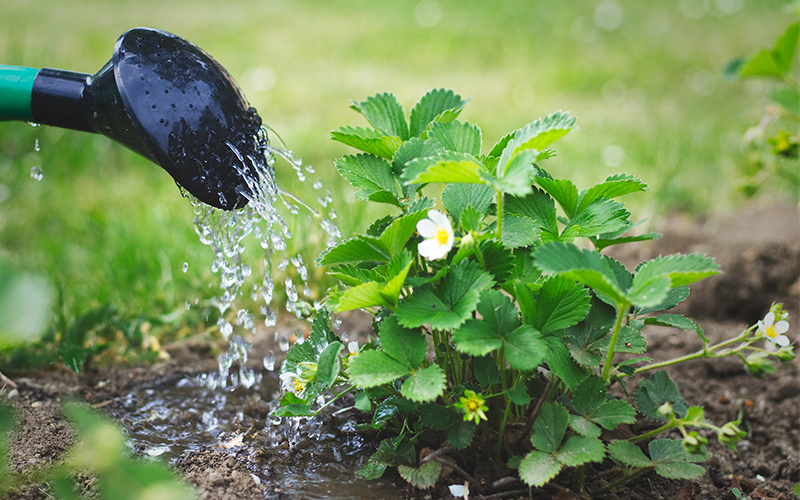
Although strawberries are easy to grow, knowing how and when to water, mulch, and fertilize them will help you get the most out of your strawberry dream endeavors.
How to Water Strawberries
Strawberries need consistent moisture to thrive, but they are also sensitive to overwatering. Water your strawberries deeply once a week, or more frequently during hot, dry weather. Avoid getting the leaves wet when watering, as this can lead to fungal diseases. A soaker hose or drip irrigation system can help provide consistent moisture without wetting the foliage.
How to Mulch Strawberries
Mulching around your strawberry plants will help retain moisture, suppress weeds, and keep the fruit clean. Use a layer of straw, shredded leaves, or pine needles. But avoid using uncomposted manure or fresh grass clippings, as these can attract pests and contribute to fungal diseases (not to mention, you may inadvertently carry over herbicides into your growing beds).
How to Fertilize Strawberries
Strawberry plants benefit from regular fertilization throughout the growing season. Apply a balanced fertilizer, such as 10-10-10, every four to six weeks. But be careful not to over-fertilize, as this can lead to excessive foliage growth and reduced fruit production.
4. How to Harvest and Store Strawberries
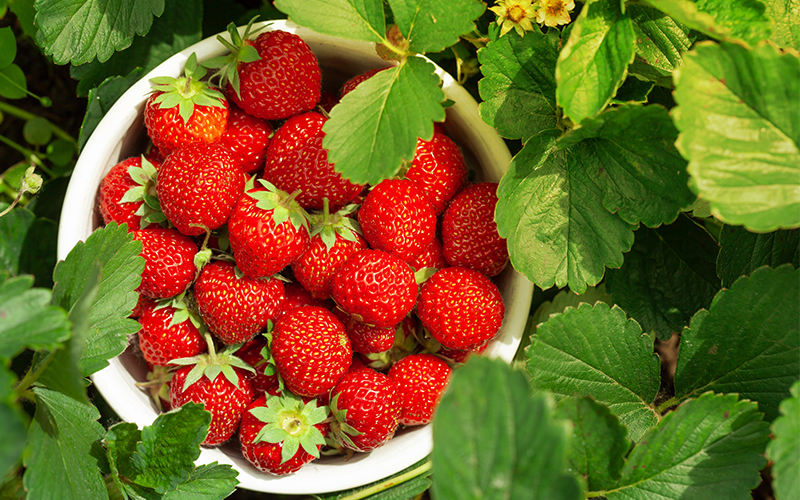
Here are a few tips on how & when to best harvest strawberries, and how to best store them.
How to Harvest Strawberries
- Strawberries are ripe and ready to pick when they’re fully red and slightly soft to the touch.
- Gently pull the berry off the stem, being careful not to bruise the fruit or damage the plant.
- Harvest strawberries in the morning when they’re at their sweetest.
- Don’t wash the strawberries until you’re ready to use them, as water can cause them to spoil more quickly.
How to Store Your Strawberry Harvest
- When storing freshly picked strawberries, it's important to keep them dry and cold to prevent them from spoiling.
- After removing any damaged or moldy berries from a day’s harvest, store unwashed strawberries in a shallow container lined with paper towels to absorb any moisture, and cover them loosely with plastic wrap.
- Eat within a few days for the best flavor and wash just before using them.
5. Top 3 Ways to Use Strawberries in Garden Design
(Above) Strawberries circle a bubbling fountain in this welcoming entry garden designed by Christian Douglas. Christian will often use strawberries as an edible groundcover in his food-forward designs. Read our interview with him here. Photo by Adam Potts.
Just because strawberry plants provide a bountiful harvest, don’t limit your thinking of them simply as fruit producers. They can also be a beautiful addition to your garden design. Here are three of our favorite ideas for how to use strawberries to enhance the overall look and function of your garden.
1. Containers
Strawberries grow very well in containers—on their own or mixed in with other plants, as they make great “fillers” and “spillers.”
Top 4 Reasons to grow strawberries in containers:
- Containers help you grow strawberries in a limited space.
- It keeps them closer to where you’ll hang out, making maintenance and harvesting more convenient.
- Strawberries look great in a container, providing the "filler" and "spiller" value in combination container plantings.
- Planting strawberries in containers helps avoid slug damage in locations where this can be an issue.
You could use a typical container, window box, hanging basket (see how to plant a strawberry hanging basket in this video), or anything with soil. Just make sure they are at least 10-12 inches deep and wide and have drainage holes. There are even containers with holes along the side designed specifically for strawberries, known as strawberry jars or pots.
Fill the container with a high-quality potting mix and plant the strawberries as you would in the ground, making sure to keep the crown of the plant at or above the grade of the soil.
Water them regularly, as the soil will dry out more quickly in containers than if they were planted in the ground.
2. Border Plants
Strawberry plants make for a beautiful border at the edge of your landscape beds and along meandering paths. Not only will they add pops of green and red to your garden, but they will also provide a tasty treat as you journey through your outdoor spaces.
3. Groundcover
Strawberries can also be a very effective groundcover in a sunny location, as they have a low-lying habit and their runners will create a lush carpet of green over time. Like other groundcovers, they will help suppress weeds and retain moisture.
6. Best Strawberries for Production and Taste
Eversweet
Strawberry
Thrives in the hot climates of southern regions and is known as an "everbearing" variety. Produces a spring harvest, followed by subsequent harvests every six weeks throughout the summer and into the fall season. The berries are sizable, deliciously sweet, and ideal for eating fresh or in jams. Partial to full sun. Up to 8" tall, 18" wide. Zones 4-9.
Seascape
Strawberry
A cross between two popular varieties, Seascape is highly productive over a long season, yielding large, delicious berries with excellent flavor. This ever-bearing strawberry has good disease resistance and produces well in a wide range of climates. May remain evergreen in frost-free areas. Full sun. Zones 4-9. Up to 12" tall, 24" wide.
Albion
Strawberry
Bursting with sweetness, this everbearing selection is distinguished by its conical, symmetrically shaped fruit with a firm texture and superior flavor. Albion is high yielding and tolerates heat and humidity. Resistant to verticillium wilt, Phytophthora crown rot, and anthracnose. May remain evergreen in frost-free areas. Full sun. Up to 12" tall, 24" wide. Zones 3-9.
7. Strawberry & Angel Food Cake Trifle Recipe
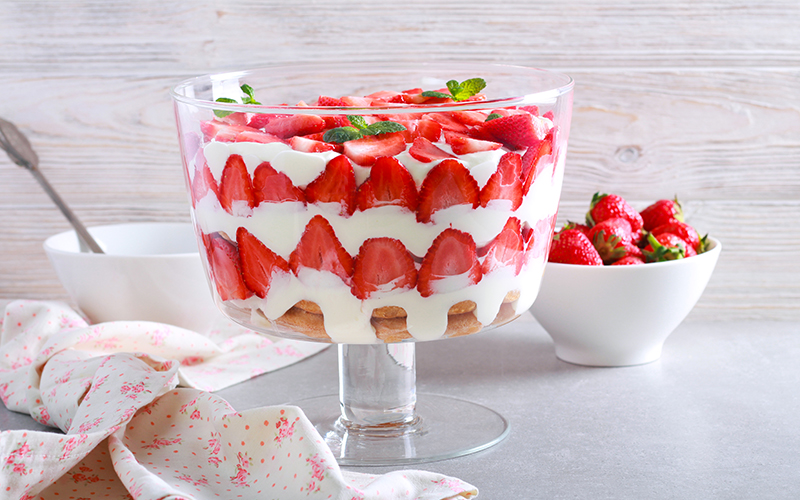
Sure, strawberry plants can be grown in your garden as a ground cover or border; but it’s most likely that you’re growing them for their oh-so-sweet berries. With that in mind we’re sharing one of our favorite strawberry recipes – Strawberry & Angel Food Cake Trifle. It’s super tasty and super easy to make!
Ingredients
- 4 cups fresh strawberries
- 1 cup 2% milk
- 1 cup sour cream
- 1 3.4-ounce package of instant vanilla pudding mix
- 2 cups heavy whipping cream
- 1 angel food cake
Tools & Utensils
- Large mixing bowl
- Whisk or electric mixer
- Measuring cups
- Large, flexible rubber spatula
- Knife and spoons
- 3-quart glass bowl
Instructions
Making the Cuts:
- Slice strawberries. (Save 1 or 2 to garnish the top of the trifle.)
- Cut angel food cake into 1” cubes (which will take approximately half of a typical store-bought angel food cake).
- Set both aside.
Whipping the Cream:
- In a large mixing bowl, beat the milk, sour cream, and instant vanilla pudding mix with an electric mixer or whisk (and make sure it’s instant vanilla pudding mix!).
- Fold in the heavy whipping cream.
Assembling the Trifle:
- Add about ½ of the cream mixture to the bottom of a 3-quart glass bowl.
- Add about ½ of the angel food cake cubes on top of the cream mixture.
- Add 2/3 of the strawberry slices on top of the angel food cake cubes.
- Add the remaining angel food cake cubes.
- Add the remaining cream mixture.
- Garnish by slicing and adding the 1 or 2 strawberries you set aside to the top.
Refrigerate for a couple of hours, then serve & enjoy!
NOTES:
- To ensure that your trifle is at its freshest, prepare it the day you plan to serve it; otherwise, it could become very soggy.
- Store leftovers covered in the refrigerator.
- Consider adding fresh blueberries to the mix, especially if you’re hosting a Fourth of July gathering!
Learn More About Growing Edible Plants Confidently
- Learn how to plant a strawberry hanging basket in this video
- Edible Landscape Design: Lessons from an Expert
- Blueberry Care Guide
- Ultimate Guide to Growing Berries
- Plant a Berry Garden for Winter Birds
- Top 10 Drought-Tolerant Edible Plants
- 5 Easy Steps for Growing Grapes
- How to Grow Fig Trees
- Keep Strawberries Fruiting in Late Summer
- Putting Container Planted Berries to Bed
- Grow a Grill Garden
About the Author and Designer
Doug Scott is the owner and lead designer at Redeem Your Ground, an exterior design firm, based in Atlanta, GA. Through his designs, Doug hopes to create outdoor spaces that reflect each clients wants to live outside at home. Doug and his wife, Brittany, also have a family, home & garden blog by the same name. They share stories, helpful information, and instructional how-to’s—hoping to enable and inspire others to live more fully at home.





